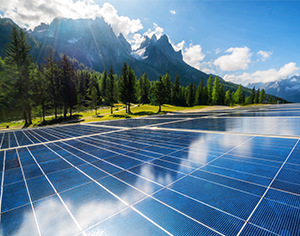Views: 6 Author: Site Editor Publish Time: 2021-11-16 Origin: Site

solar energyPower plants, often referred to as solar panels, convert solar energy directly into electricity.In a solar panel, photons emitted by the sun separate the outer electrons of the semiconductor material from the atomic bonds.When electrons are forced to move in the same direction, an electrical current can be generated to power electronic devices or deliver power to the grid.
Photovoltaic power generation has been one of the subjects of scientific research since the theory of photovoltaic power generation in France in 1839.Currently, the international photovoltaic industry market continues to expand as major research teams in the US – in Japan and Europe accelerate the industrialization of their respective solar systems.
Although the components of a solar panel power generation system are different, all components include several layers of material from the glossy side to the back side.Sunlight first passes through the protective layer (usually glass) and then enters the interior of the cell through the transparent contact layer.At the center of the assembly is an adsorbent material that absorbs photons to complete 'photogenerated current'.The semiconductor material in it depends on the specific PV system requirements.
Below the adsorbent layer material is the back metal layer, which completes the conduction of the circuit.A composite thin film layer is placed under the back metal layer to provide a waterproof and isolated photovoltaic module.An additional protective layer is usually added to the back of the PV module.The protective layer is made of glass - aluminum or plastic.
semiconductor
Photovoltaic systemThe semiconductor material in can be silicon - polycrystalline film or single crystal film.Silicon materials include monocrystalline silicon - polycrystalline silicon and amorphous silicon.Monocrystalline silicon has a regular structure, which has a higher photoelectric conversion rate than polycrystalline silicon.
Silicon atoms in amorphous silicon are randomly distributed and have a lower photoelectric conversion rate than single crystal silicon.However, it can capture more photons while adding germanium or carbon to amorphous silicon from crystalline silicon.Alloying can enhance this property.
Copper indium selenide (CIS) - cadmium telluride (CdTe) and thin film silicon are commonly used polycrystalline thin film materials and materials with high photoelectric conversion rates, such as gallium arsenide (GaAs).Usually also includes a single crystal silicon film material.These materials are used in specific photovoltaic power generation fields due to their unique properties.These properties include: crystallinity - band gap size - absorption properties and ease of processing.Effects of External Factors on Semiconductors The order of atoms in the crystal structure determines the crystallinity of semiconductor materials, and the charge transfer current density and energy conversion efficiency of solar panel cells are affected by crystallinity.The band gap of a semiconductor material is the small amount of energy required to convert an electron from a bound state to a free state (ie, allowing the electron to conduct).The band gap size is usually denoted by Eg, which describes the energy difference between the valence and conduction bands.The valence band of a semiconductor material is a low energy level, and the conduction band is a high energy level.The absorption coefficient is used to characterize the distance a photon of a specific wavelength travels through a medium, which determines the ability of the photon to be absorbed by the medium.The absorption coefficient is determined by the cellular material and the wavelength at which the photon is absorbed.